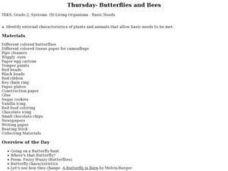Curated OER
Following Directions - Ndakinna Wilderness Project
Students draw a diagram of the steps used to camouflage a person. In this biology lesson, students watch and take notes on a video about using camouflage as a tool to observe nature. Then students follow instructions to create a diagram...
Curated OER
The Theory of Evolution
In this biology worksheet, students identify and locate various vocabulary terms pertaining to the Theory of Evolution. There are 30 biology terms related to evolution located in the word search.
Curated OER
Animal Environments
In this science activity, students match 15 terms about animals and the environment with the definitions or descriptions. Answers are included.
Curated OER
Caterpillar Camouflage
First graders are introduced to the concept of camouflage. Individually, they color a paper caterpillar to match its surroundings to not be attacked by prey. To end the lesson, they participate in a game in which some caterpillars...
Curated OER
Butterfly Camouflage
Fifth graders discuss camouflage and warnings by butterflies as a class. Students design and color their own butterflies that they are to place somewhere in the classroom. Students explain why their butterfly is colored the way that it...
Curated OER
Froggy Fun
Students exploring about frogs and their environment. They describe what camouflage is and why it is useful to frogs especially in the environment that frogs live in. They also draw a picture of a frog in its habitat.
Curated OER
Biology: Butterfly Activities
Second graders examine various types of butterflies and insects around their school. They identify differences between beetles and butterflies. Students examine books about butterflies, complete symmetry drawings, and make ladybug key...
Curated OER
Nest Construction and Area Management Activities
Students construct a nest for a fictitious ground-nesting bird.They create models of the bird (along with its eggs) that might theoretically live in this habitat. They write in a daily journal about what happens to their nests in a...
Curated OER
Catch Me if You Can
Third graders investigate behavioral and physical adaptations, such as camouflage, that allow animals to respond to life needs.
Curated OER
Disguise! Disguise!
Third graders explore how some animals disguise or camouflage themselves as a form of protection.
Curated OER
Learning Activities: What Color Am I?
Learners identify various species of anurans by their skin coloration. They describe how coloration contributes to survival.
PBS
Pbs Learning Media: Ndakinna Wilderness Project
In this video segment from WILD TV, a guide describes how to camouflage a person's body to avoid being detected in the wilderness.
PBS
Nova: Seeing Through Camouflage
See if you can identify the type of camouflage shown in 12 different animals. Types of camouflage include mimicry, disguise, disruptive coloration,and concealing coloration.
PBS
Pbs: Champion Birds
The PBS video series "The Life of Birds" is accompanied with this site. There are articles about several aspects of birds and their behavior. This one chronicles the highest, fastest, and most extreme birds. There are lots of examples.
DOGO Media
Dogo News: Butterfly Wings: More Than Meets the Eye
Learn about the camouflage that butterflies use both in their chrysalis and adult stages to avoid being eaten by predators.
CK-12 Foundation
Ck 12: Biology: Mollusks
[Free Registration/Login may be required to access all resource tools.] Discusses characteristics of mollusks.
San Diego Zoo Global
San Diego Zoo: Chameleon
Read all about the chameleon. The "Quick Facts" tells you information in a nutshell, and the main text explains how the chameleon changes colors. You can even hear the sound of a chameleon. An interesting resource.
Lincoln Park Zoo
Lincoln Park Zoo: Baringo Giraffe
This site about the Baringo Giraffe, provides information ranging from a detailed description to special adaptations that the giraffe has developed. A good site for student research.
Unite for Literacy
Unite for Literacy: Mystic Aquarium: Be a Friend to Frogs!
Learn interesting facts about frogs in this book. Frogs face dangers from human activities and you will read about some things that you can do to protect them. Includes audio narration in English and Spanish with text in English.
Utah Education Network
Uen: Disguise! Disguise!
Learn how some animals disguise or camouflage themselves as a form of protection.
Utah Education Network
Uen: Animal Adaptations
A multitude of activities provide help with understanding animal adaptations.
American Museum of Natural History
American Museum of Natural History: Crazy Camouflage
Create a flounder fish that's hard to spot. In this hands-on activity, students gather evidence to explore how camouflage helps animals survive.
Exploratorium
Exploratorium: Frogs, a Disappearing Act
At this site students can read about how frogs camouflage to avoid predators. There is an interactive exhibit too! (Must have the Shockwave plug-in to see animation.)
Scholastic
Scholastic: Build Your Own Caterpillar
Choose adaptation features that will help a caterpillar to survive when predators are nearby. Students enter their reasons for choosing the characteristics they did, and receive feedback.






















